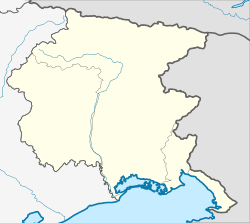
Back غرتسية Arabic Gorizia AST قوریتزیا AZB Гарыцыя Byelorussian Гориция Bulgarian Gorizia Breton Gorizia Catalan Горици CE Gorizia (munisipyo) CEB Gorice Czech
This article needs additional citations for verification. (October 2019) |
Gorizia
| |
|---|---|
| Comune di Gorizia Občina Gorica Comun di Gurize | |
 The old part of Gorizia seen from the castle in August 2008 | |
| Coordinates: 45°56′N 13°37′E / 45.933°N 13.617°E | |
| Country | Italy |
| Region | Friuli-Venezia Giulia |
| Province | Gorizia |
| Frazioni | Castello, Lucinico (Ločnik), Oslavia (Oslavje), Piuma (Pevma), San Mauro (Šmaver), Sant'Andrea (Štandrež), Straccis (Stražišče), Vallone dell'Acqua, Gradiscutta, Piedimonte (Podgora) |
| Government | |
| • Mayor | Rodolfo Ziberna (Forza Italia) |
| Area | |
| • Total | 41 km2 (16 sq mi) |
| Elevation | 86 m (282 ft) |
| Population (November, 2022)[2] | |
| • Total | 33,584 |
| • Density | 820/km2 (2,100/sq mi) |
| Demonym(s) | Goriziani (Italian) Goričani (Slovene) |
| Time zone | UTC+1 (CET) |
| • Summer (DST) | UTC+2 (CEST) |
| Postal code | 34170 |
| Dialing code | 0481 |
| ISTAT code | 031007 |
| Patron saint | Saints Hilary and Tatian |
| Saint day | March 16 |
| Website | Official website |
Gorizia (Italian pronunciation: [ɡoˈrittsja] ; Slovene: Gorica [ɡɔˈɾìːtsa]), colloquially stara Gorica 'old Gorizia'[3][4] to distinguish it from Nova Gorica (Standard Friulian: Gurize, Southeastern Friulian: Guriza; Bisiacco: Gorisia; German: Görz [ɡœʁts] ), is a town and comune (municipality) in northeastern Italy, in the autonomous region of Friuli-Venezia Giulia. It is located at the foot of the Julian Alps, bordering Slovenia. It is the capital of the Regional decentralization entity of Gorizia and is a local center of tourism, industry, and commerce. Since 1947, a twin town of Nova Gorica has developed on the other side of the modern-day Italy–Slovenia border. The region was subject to territorial dispute between Italy and Yugoslavia after World War II: after the new boundaries were established in 1947 and the old town was left to Italy, Nova Gorica was built on the Yugoslav side. The two towns constitute a conurbation, which also includes the Slovenian municipality of Šempeter-Vrtojba. Since May 2011, these three towns have been joined in a common trans-border metropolitan zone, administered by a joint administration board.[5]
The name of the town comes from the Slovene word gorica 'little mountain', which is a common toponym in Slovene-inhabited areas.[6]
- ^ "Superficie di Comuni Province e Regioni italiane al 9 ottobre 2011". Italian National Institute of Statistics. Retrieved March 16, 2019.
- ^ "Popolazione Residente al 1° Gennaio 2018". Italian National Institute of Statistics. Retrieved March 16, 2019.
- ^ Meinhof, Ulrike Hanna (2002). Living (with) Borders: Identity Discourses on East-West Borders in Europe. Aldershot: Ashgate. p. 50.
- ^ Fidermuc, Katarina (May 14, 2017). "Za železnico lahko hkrati stojiš v dveh Goricah". Delo (in Slovenian). Retrieved December 27, 2017.
- ^ di Francesco Fain (May 12, 2011). "Patto Gorizia-Nova Gorica c-e la firma – Cronaca" (in Italian). Il Piccolo. Archived from the original on March 10, 2012. Retrieved August 25, 2012.
- ^ Snoj, Marko (2009). Etimološki slovar slovenskih zemljepisnih imen. Ljubljana: Modrijan. p. 144.




